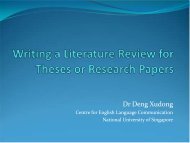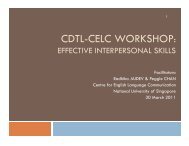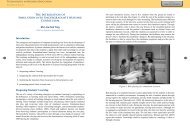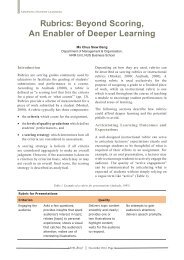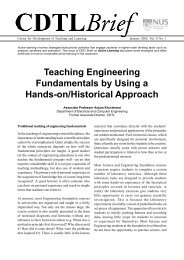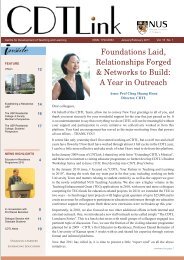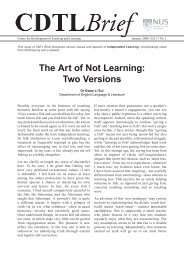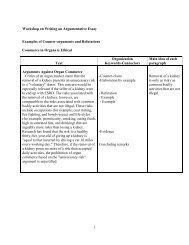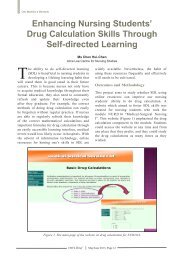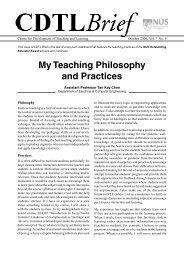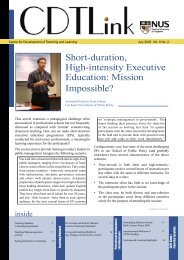Religion as a Heuristic Anchor: Studying the Various ... - CDTL
Religion as a Heuristic Anchor: Studying the Various ... - CDTL
Religion as a Heuristic Anchor: Studying the Various ... - CDTL
You also want an ePaper? Increase the reach of your titles
YUMPU automatically turns print PDFs into web optimized ePapers that Google loves.
Centre for Development of Teaching and Learning October 2006, Vol. 9 No. 5<br />
Cross-disciplinary courses are becoming more common in many tertiary institutions. This issue of <strong>CDTL</strong> Brief on Crossdisciplinary<br />
Teaching and Learning discusses issues that concern cross-disciplinary studies.<br />
<strong>Religion</strong> <strong>as</strong> a <strong>Heuristic</strong><br />
<strong>Anchor</strong>: <strong>Studying</strong> <strong>the</strong> <strong>Various</strong><br />
Interdisciplinary Approaches<br />
XD2101 “Approaches to <strong>the</strong> Study of <strong>Religion</strong>”<br />
is a module that aims to introduce students to <strong>the</strong><br />
history of religious studies through a review of <strong>the</strong><br />
different ways religion h<strong>as</strong> been understood and<br />
defined. Students are introduced to important writers<br />
<strong>as</strong>sociated with various disciplines in different<br />
weeks, and students must reflect on why different<br />
disciplines work in different ways.<br />
My experience shows that most students enrolled<br />
in this module have fairly well-formulated opinions<br />
about religiosity, ranging from vehement faith to<br />
strong skepticism. Many students know that <strong>the</strong>y are<br />
already ‘part of’ a religion, but few will have thought<br />
about religion <strong>as</strong> an academic enterprise. The first<br />
objective of XD2101, <strong>the</strong>refore, is to interrogate <strong>the</strong><br />
very conditions by which ‘religion’ itself h<strong>as</strong> been<br />
produced <strong>as</strong> a linguistic and discursive category in<br />
<strong>the</strong> academe. This involves, for example, examining<br />
<strong>the</strong> Judeo-Christian lineage of <strong>the</strong> term, and<br />
discussing whe<strong>the</strong>r or not a faith such <strong>as</strong> Buddhism<br />
or Hinduism can be situated within its discursive<br />
parameters.<br />
The second main objective is to give students a<br />
straightforward introduction to <strong>the</strong> main features<br />
of social sciences disciplines thorough <strong>the</strong> lens<br />
of religion. The module is structured around a<br />
discussion of five or six individual <strong>the</strong>orists of<br />
religion, whose approaches to religion exemplify <strong>the</strong><br />
wider disciplinary methodologies <strong>the</strong>y employ. For<br />
Dr Julius Bautista<br />
Visiting Fellow<br />
Department of South E<strong>as</strong>t Asian Studies<br />
example, we discuss Emile Durkheim and Max Weber<br />
according to <strong>the</strong>ir works on society and religion,<br />
<strong>as</strong> well <strong>as</strong> Sigmund Freud and James Frazer for<br />
psychology and anthropology respectively. Normally,<br />
<strong>the</strong> <strong>the</strong>orists studied in <strong>the</strong> module are ‘founding<br />
fa<strong>the</strong>rs’ of <strong>the</strong> discipline. It is an interesting part of<br />
<strong>the</strong> module to demonstrate that many disciplines in<br />
<strong>the</strong> social sciences, such <strong>as</strong> anthropology, philosophy<br />
and sociology, were founded by <strong>the</strong>orists who<br />
were very much concerned with religious topics.<br />
T h e m o d u l e , t h e r e f o r e , i s b y n a t u r e a n<br />
interdisciplinar y one. In addition to this, it<br />
is i mpor t a nt to see t he topic of religion <strong>as</strong><br />
a com mon ‘anchor’ by which various social<br />
science methodologies can be compared with one<br />
ano<strong>the</strong>r. The functionalist approach to religion<br />
by anthropologist Edward Tylor, for example, is<br />
contr<strong>as</strong>ted with a view of religion <strong>as</strong> a c<strong>as</strong>e of<br />
universal neurosis, <strong>as</strong> exemplified by Sigmund<br />
Freud, or <strong>the</strong> focus on religion <strong>as</strong> societal cohesion<br />
exemplified by <strong>the</strong> work of sociologist Emile<br />
Durkheim. The fundamental b<strong>as</strong>is by which <strong>the</strong><br />
module is conceptualised is that ‘religion’ is an<br />
effective heuristic by which students can learn<br />
various disciplinary approaches and compare <strong>the</strong>m<br />
with one ano<strong>the</strong>r.<br />
The module is a cross-disciplinary (XD) course<br />
that offers a foundation for <strong>the</strong> study of <strong>the</strong><br />
world’s religions. In this respect, it complements
GEK1045 “Introduction to World <strong>Religion</strong>s”, a<br />
general knowledge (GEK) module taught in <strong>the</strong><br />
first semester. The general aim of both <strong>the</strong> GEK<br />
and <strong>the</strong> XD modules (both foundational modules<br />
for a minor in religious studies) is to foster an<br />
academic environment in which students can learn<br />
and exchange ide<strong>as</strong> about religion in a spirit that<br />
Teaching “Simplicity”<br />
Dr Rajesh R. Parwani<br />
University Scholars Programme and Department of Physics<br />
In this article I discuss my experience in teaching<br />
UQR2206 “Simplicity”, a module in <strong>the</strong> University<br />
Scholars Programme. UQR2206 is a science/<br />
technology-b<strong>as</strong>ed module without prerequisites<br />
and open to USP students from all faculties. A<br />
typical cl<strong>as</strong>s would consist of students from <strong>the</strong>ir<br />
first semester at NUS to those in <strong>the</strong>ir third year of<br />
study.<br />
The objectives of <strong>the</strong> module are to introduce<br />
students to (i) <strong>the</strong> scientific method <strong>as</strong> used by<br />
practitioners, and (ii) <strong>the</strong> various qualitative concepts<br />
and quantitative tools researchers use to understand<br />
and model observed phenomena. Some of <strong>the</strong><br />
challenges of teaching such a module are likely to<br />
be common to o<strong>the</strong>r cross-disciplinary modules. I<br />
shall discuss <strong>the</strong>se challenges below and <strong>the</strong> various<br />
approaches I have experimented with.<br />
The first problem is that students come from<br />
diverse disciplines, with very different science and<br />
ma<strong>the</strong>matics backgrounds. Thus <strong>the</strong> subject matter<br />
chosen for weekly discussions must be nei<strong>the</strong>r too<br />
e<strong>as</strong>y nor too advanced. In o<strong>the</strong>r words, <strong>the</strong> discussion<br />
subject should ideally sustain <strong>the</strong> interest of all<br />
students over long periods and encourage <strong>the</strong>m to<br />
participate enthusi<strong>as</strong>tically.<br />
However, by choosing interesting, and sometimes<br />
unconventional, material to solve <strong>the</strong> first problem,<br />
one may face a second problem—<strong>the</strong> highly<br />
pragmatic nature of some students who want to know<br />
how what <strong>the</strong>y are learning is useful to <strong>the</strong>m.<br />
The third problem with “Simplicity” <strong>as</strong> a module<br />
in quantitative re<strong>as</strong>oning is <strong>the</strong> aversion many<br />
humanities students have to ma<strong>the</strong>matics. Many<br />
of <strong>the</strong>se students have terrifying memories of how<br />
<strong>the</strong>y spent <strong>the</strong>ir pre-university days mindlessly<br />
memorising countless formulae that were <strong>the</strong>n used<br />
with little understanding to solve highly artificial<br />
examination problems. Surprisingly, many science<br />
<strong>CDTL</strong> Brief / October 2006, Page 2<br />
is tolerant, open and lively. While <strong>the</strong> lectures<br />
and tutorials provide a b<strong>as</strong>ic, straightforward<br />
outline of each of <strong>the</strong> world’s major faiths, <strong>the</strong><br />
minor is designed so that students’ personal ide<strong>as</strong><br />
about religion can be brought to bear on current<br />
scholarship and research on religion.<br />
and engineering students also think that memorising<br />
and using formulae is what ma<strong>the</strong>matics, physics<br />
and engineering are all about. However, science and<br />
engineering students differ in that <strong>the</strong>y are slightly<br />
more accepting of ma<strong>the</strong>matics than <strong>the</strong> humanities<br />
students.<br />
I solve <strong>the</strong> first problem by choosing readings from<br />
various disciplines and try to use non-standard<br />
examples to illustrate <strong>the</strong> concepts. In this way, even<br />
students from physics or ma<strong>the</strong>matics, who may have<br />
covered similar b<strong>as</strong>ic material elsewhere, would learn<br />
something new. Fur<strong>the</strong>rmore, I constantly relate <strong>the</strong><br />
abstract concepts to real life examples and point<br />
out connections between similar ide<strong>as</strong> in different<br />
disciplines. In this way, students are reminded that<br />
science is ultimately about understanding <strong>the</strong> real<br />
world and how understanding something at <strong>the</strong><br />
conceptual level in one discipline can help solve<br />
similar problems in ano<strong>the</strong>r. Hence, <strong>the</strong> second<br />
problem mentioned above is also resolved.<br />
To address <strong>the</strong> third problem, I introduce <strong>the</strong><br />
ma<strong>the</strong>matics gradually, with a liberal use of simple<br />
examples, computer simulations, judicious analogies<br />
and fun activities (e.g. ma<strong>the</strong>matical modelling of<br />
<strong>the</strong> love between Romeo and Juliet)—all meant to<br />
lull students into a relaxed frame of mind and help<br />
<strong>the</strong>m forget <strong>the</strong>ir preconceptions of quantitative<br />
re<strong>as</strong>oning. At <strong>the</strong> end of <strong>the</strong> day, I hope to have taught<br />
students something new and useful that <strong>the</strong>y could<br />
remember for a longer period than some meaningless<br />
formulae.<br />
An example of a computer simulation used in<br />
teaching <strong>the</strong> module is <strong>the</strong> Game of Life 1 that<br />
illustrates how remarkably simple rules can give<br />
rise to both diversity (<strong>as</strong> a result of different initial<br />
1. The Game of Life is available online: http://www.math.com/<br />
students/wonders/life/life.html and students can play it before<br />
or after cl<strong>as</strong>s discussions.
conditions) and emergent complexity, but how<br />
difficult it would be to guess those rules just by<br />
looking at <strong>the</strong> end result. This simulation illustrates<br />
with minimal fuss why <strong>the</strong>re is merit in <strong>the</strong> scientific<br />
method used by explorers in seeking simple universal<br />
rules underlying natural phenomena.<br />
Ano<strong>the</strong>r example is Boids 2 —a computer simulated<br />
program that produces very realistic f locking<br />
behaviour of digital birds, illustrating <strong>the</strong> concept<br />
of self-organisation. When students learn that <strong>the</strong><br />
techniques used in Boids are also used in many blockbuster<br />
movies and animations, students realise that<br />
science can be both serious and fun.<br />
There is, of course, no substitute for <strong>the</strong> real thing—<br />
<strong>the</strong> group project (<strong>the</strong> most challenging part of <strong>the</strong><br />
module). This is where students are <strong>as</strong>ked to select<br />
a recently published paper that uses quantitative<br />
re<strong>as</strong>oning and <strong>the</strong> scientific method and do a critical<br />
review of that paper. Thus, students have to first<br />
understand what <strong>the</strong> paper is about, m<strong>as</strong>ter <strong>the</strong><br />
ma<strong>the</strong>matical tools <strong>the</strong> authors used, surface <strong>the</strong><br />
various underlying <strong>the</strong>oretical <strong>as</strong>sumptions in <strong>the</strong><br />
ma<strong>the</strong>matical models, critique those <strong>as</strong>sumptions<br />
and conclusions, and finally, suggest improvements<br />
for a potential future study.<br />
2. Boids (http://www.red3d.com/cwr/boids/ ) w<strong>as</strong> a computer<br />
program originally developed by Craig Reynolds in 1986 to<br />
simulate <strong>the</strong> flocking behaviour of birds.<br />
Cross-disciplinary teaching is one of <strong>the</strong> most<br />
important and complicated issues in pedagogy<br />
characterised mainly by specialisation and <strong>the</strong><br />
appearance of new disciplines today. In this new<br />
reality, <strong>the</strong>re is a big need for courses that provide<br />
students with a wider view of lateral connections<br />
between disciplines.<br />
When dealing with cross-disciplinary teaching, it<br />
is first necessary to clarify <strong>the</strong> distinction between<br />
disciplinary courses and cross-disciplinary courses.<br />
Disciplinary courses usually deal with a specific field<br />
of knowledge, delving relatively deep into details<br />
<strong>CDTL</strong> Brief / October 2006, Page<br />
For many students, <strong>the</strong> critical reading of a technical<br />
journal article is often <strong>the</strong>ir first experience in taking<br />
<strong>the</strong> indispensable preliminary step in academic<br />
research. To make <strong>the</strong> experience even more<br />
realistic and memorable, students are to give an<br />
oral presentation of <strong>the</strong>ir project to <strong>the</strong> whole cl<strong>as</strong>s,<br />
after which presenters will be ‘grilled’ just <strong>as</strong> in any<br />
science workshop for professionals.<br />
Anecdotal evidence indicates that <strong>the</strong> group project<br />
comes in handy for students whose future project<br />
work involves ma<strong>the</strong>matical modelling. Even for<br />
those who do not intend to fur<strong>the</strong>r <strong>the</strong>ir studies in<br />
science, <strong>the</strong> project arguably brings students <strong>as</strong> close<br />
<strong>as</strong> possible to <strong>the</strong> way actual science is done and<br />
perhaps, dispels <strong>the</strong>ir naïve thoughts that scientists<br />
can e<strong>as</strong>ily make breakthroughs by day-dreaming.<br />
In addition to <strong>the</strong> group project, each student h<strong>as</strong> to<br />
make ano<strong>the</strong>r -minute oral presentation on ‘scientific<br />
method or quantitative re<strong>as</strong>oning in <strong>the</strong> news’. Students<br />
search for a recent news item and <strong>the</strong>n give a concise<br />
but intelligible talk to <strong>the</strong> whole cl<strong>as</strong>s. This teaches<br />
students how to digest everyday scientific news, distil<br />
its essence and communicate it to <strong>the</strong>ir peers.<br />
Some of <strong>the</strong> resources used in “Simplicity” are available at <strong>the</strong> course<br />
website: http://staff.science.nus.edu.sg/~parwani/sim/simindex.<br />
html.<br />
Cross-disciplinary Theories for<br />
Cross-disciplinary Teaching<br />
Dr Mosseri Avraham<br />
The David Azrieli School of Architecture, Faculty of <strong>the</strong> Arts,<br />
Tel Aviv University, Israel<br />
and micro <strong>as</strong>pects. It is more focused on a specific<br />
field of knowledge and less with <strong>the</strong> ‘big picture’.<br />
On <strong>the</strong> contrary, cross-disciplinary courses deal<br />
with connections, interrelations and interactions<br />
between different fields of knowledge. These courses<br />
are more general in character and <strong>the</strong>y can be called<br />
macro-courses.<br />
These two kinds of courses are important, interdependant<br />
and interrelated. Both give students a high<br />
level of understanding. However, it is much harder<br />
to teach cross-disciplinary courses successfully<br />
because:
a. Cross-disciplinary courses require teachers with<br />
a broad interdisciplinary knowledge. In this era of<br />
specialisation, it is relatively rare to find people<br />
who have studied laterally and are able to think<br />
in a cross-disciplinary manner.<br />
b. Academic institutions traditionally encourage<br />
disciplinary research. The low number of crossdisciplinary<br />
researches compared to disciplinary<br />
researches is an important indicator of <strong>the</strong><br />
situation despite <strong>the</strong> growing tendency towards<br />
more cross-disciplinary research.<br />
c. Cross-disciplinary <strong>the</strong>ories are rare and existing<br />
ones are not well-<strong>as</strong>similated into <strong>the</strong> area of<br />
teaching.<br />
d. Objectively, it is much complicated to teach crossdisciplinary<br />
courses.<br />
In an era characterised by rapid accumulation of<br />
new information, cross-disciplinary <strong>the</strong>ories can<br />
help teachers and students control, manage and<br />
understand large amount of information better.<br />
Such <strong>the</strong>ories can also contribute to <strong>the</strong> creation of<br />
new systems and processes with cross-disciplinary<br />
characteristics.<br />
Few cross-disciplinary <strong>the</strong>ories have been developed<br />
throughout history. Amongst <strong>the</strong>se <strong>the</strong>ories, it seems<br />
that <strong>the</strong> system <strong>the</strong>ory by Bertalanfy (1968) (and<br />
o<strong>the</strong>rs who later developed this <strong>the</strong>ory) is <strong>the</strong> most<br />
fundamental one that can be turned into a b<strong>as</strong>ic tool<br />
for developing cross-disciplinary understanding. I<br />
shall discuss how <strong>the</strong> potential of <strong>the</strong> system <strong>the</strong>ory<br />
and its developments can help in teaching and<br />
understanding cross-disciplinary thinking.<br />
The system <strong>the</strong>ory is an interdisciplinary <strong>the</strong>ory<br />
that analyses <strong>the</strong> <strong>the</strong>oretical and practical properties<br />
of systems from a cross-disciplinary point of view.<br />
The <strong>the</strong>ory integrates principles and concepts from<br />
many fields of research such <strong>as</strong> biology, chemistry,<br />
<strong>the</strong>rmodynamics, engineering, social sciences,<br />
ecology among o<strong>the</strong>rs. It deals with <strong>the</strong> definition and<br />
analysis of systems, typology of different systems<br />
and behaviour of systems in different conditions and<br />
environments. The <strong>the</strong>ory also stresses <strong>the</strong> relations<br />
between <strong>the</strong> parts and offers a holistic perspective.<br />
<strong>CDTL</strong> Brief / October 2006, Page 4<br />
Terminologies of interdisciplinary properties (e.g.<br />
complexity, stability, entropy, energy, time, feedback,<br />
dynamics of systems) are introduced and analysed. It<br />
is important to note that <strong>the</strong> applications of system<br />
<strong>the</strong>ory can be found today in many fields and<br />
activities (e.g. Beer, 2004; Mosseri, 2005).<br />
The system <strong>the</strong>or y can be included in crossdisciplinary<br />
courses or cross-disciplinary knowledge.<br />
It is important to note that this kind of knowledge is<br />
important especially for interdisciplinary professions<br />
like medicine, architecture, ecology, town planning<br />
and o<strong>the</strong>rs.<br />
One of <strong>the</strong> most important questions in using<br />
<strong>the</strong> system <strong>the</strong>ory is: when is <strong>the</strong> right time in<br />
<strong>the</strong> teaching process to introduce this kind of<br />
knowledge? Should it be given at <strong>the</strong> beginning or<br />
<strong>the</strong> end of <strong>the</strong> studies? P<strong>as</strong>t experience shows that<br />
each alternative h<strong>as</strong> its own advantages. Exposure<br />
to such knowledge at <strong>the</strong> beginning of <strong>the</strong> studies<br />
gives students an overall introduction and crossdisciplinary<br />
vision at an early stage without specific<br />
knowledge. Introducing system <strong>the</strong>ory into at <strong>the</strong> end<br />
of <strong>the</strong> studies is also advantageous <strong>as</strong> students would<br />
already have possessed a relatively large amount of<br />
knowledge and it is <strong>the</strong>n much e<strong>as</strong>ier for <strong>the</strong>m to<br />
develop cross-disciplinary thinking. However, <strong>the</strong><br />
problem here is that <strong>the</strong> ‘big picture’ is only achieved<br />
at <strong>the</strong> end of <strong>the</strong> teaching process. A combination of<br />
<strong>the</strong>se alternatives can be a possible solution.<br />
The system <strong>the</strong>ory and its importance in crossdisciplinary<br />
teaching need to be fur<strong>the</strong>r investigated<br />
in <strong>the</strong> future b<strong>as</strong>ed on <strong>the</strong> initial ide<strong>as</strong> introduced in<br />
this article.<br />
References<br />
Beer, S. (2004). ‘Man in Garrulous Silence’. Kybernetes: The<br />
International Journal of Systems and Cybernetics. Vol. , Nos.<br />
–4, pp. 809–827.<br />
Bertalanfy, L.V. (1968). General System Theory. New York: George<br />
Braziller.<br />
Mosseri, A. (2005). ‘Integration of Science and Art in Architectural<br />
Studies in <strong>the</strong> Information Era’. In Kungolos, A.G.; Brebbia, C.A.,<br />
Beriatos, E. (Eds.), Sustainable Development and Planning II, Vol.<br />
2, pp. 1401–1410. Bologna: Wit Press.
Behavioural Studies in Real Estate:<br />
An Interdisciplinary Approach to<br />
Real Estate Education and Research<br />
On 1 June 2005, <strong>the</strong> Board of Directors of a<br />
renowned international property company decided<br />
to purch<strong>as</strong>e a piece of land in Shanghai to develop a<br />
shopping mall. The main motivation for purch<strong>as</strong>ing<br />
<strong>the</strong> land w<strong>as</strong> to incre<strong>as</strong>e <strong>the</strong> company’s presence<br />
in Shanghai despite <strong>the</strong> relatively low Net Present<br />
Value (NPV) and Internal Rate of Return (IRR) of<br />
real estate investment in China.<br />
On <strong>the</strong> same day, a Singaporean family decided to<br />
purch<strong>as</strong>e a condominium unit (The Sail @ Marina)<br />
for investment purposes. While one of <strong>the</strong> family<br />
members w<strong>as</strong> signing <strong>the</strong> sales contract, ano<strong>the</strong>r<br />
family member, who w<strong>as</strong> spending an afternoon at<br />
her friend’s condominium, w<strong>as</strong> so attracted to its<br />
resort-style concept and impressed with <strong>the</strong> level of<br />
<strong>as</strong>set management that she felt she would not mind<br />
working a lifetime to finance <strong>the</strong> purch<strong>as</strong>e of <strong>the</strong><br />
dream home she had just seen.<br />
The above scenarios depict varied decision-making<br />
processes by stakeholders in <strong>the</strong> real estate market.<br />
Unlike ordinary economic goods, real estate is<br />
often regarded <strong>as</strong> a tangible <strong>as</strong>set with a bundle<br />
of rights attached to it. It is also a more complex<br />
product due to its characteristics and operations of<br />
<strong>the</strong> real estate market. Thus, many professionals<br />
are involved in delivering goods and services in <strong>the</strong><br />
real estate market. This also implies that <strong>the</strong>re are<br />
complexities involved in <strong>the</strong> real estate development<br />
process. According to Ling and Archer (2005), <strong>the</strong><br />
property development cycle involves eight main<br />
stages, namely:<br />
1. establishing site control<br />
2. fe<strong>as</strong>ibility analysis, refinement, and testing<br />
. obtaining permits<br />
4. design<br />
5. financing<br />
6. construction<br />
7. marketing and le<strong>as</strong>ing<br />
8. operations<br />
Dr Muhammad Faishal Ibrahim<br />
Department of Real Estate<br />
<strong>CDTL</strong> Brief / October 2006, Page 5<br />
T he real est ate development cycle t akes on<br />
a systematic approach, involving inputs from<br />
various disciplines (e.g. geography, law, finance,<br />
management, marketing, economics). Among <strong>the</strong>se,<br />
few key are<strong>as</strong> have been <strong>the</strong> main focus in real estate<br />
research and education. Black, Brown, Diaz, Gibler<br />
and Grissom (200 ) mentioned that <strong>the</strong>se inputs<br />
have somehow formed “artificial boundaries” (p.<br />
85) on real estate research and education. Black et<br />
al., (200 ) called for a more holistic approach to<br />
study real estate by linking <strong>the</strong> thoughts, <strong>the</strong>ories<br />
and tools from o<strong>the</strong>r disciplines to real estate<br />
research and education. Black et al., (200 ) fur<strong>the</strong>r<br />
cited behavioural research <strong>as</strong> an area which real<br />
estate educators and professionals should develop,<br />
and claimed that all disciplines within <strong>the</strong> realms<br />
of real estate research and education “derive <strong>the</strong>ir<br />
existence from human behaviour” (p. 86). However,<br />
<strong>the</strong>re h<strong>as</strong> not been much research and understanding<br />
on behavioural perspectives in real estate research<br />
and education (Black et al., 200 ; Levy & Henry,<br />
200 ). For example, if <strong>the</strong> <strong>as</strong>sumptions of financial<br />
c<strong>as</strong>h flows are derived from human decisions, <strong>the</strong>n<br />
architects need to understand human behaviour and<br />
<strong>the</strong> built environment while real estate owners and<br />
managers should understand <strong>the</strong>ir stakeholders’<br />
attitudes and behaviour to enhance productivity.<br />
In 2004, after attending <strong>the</strong> American Real Estate<br />
Society Conference in Florida, USA, I began<br />
examining <strong>the</strong> real estate courses offered by<br />
leading universities. It w<strong>as</strong> <strong>the</strong>n that I realised <strong>the</strong><br />
apparent lack of coverage in behavioural <strong>as</strong>pects<br />
in real estate studies. The broad-b<strong>as</strong>ed education<br />
system at NUS motivated me to develop <strong>the</strong> module<br />
RE 90 “Behavioural Studies in Real Estate” <strong>as</strong><br />
one of <strong>the</strong> electives of <strong>the</strong> Bachelor of Science<br />
(Real Estate) programme for Academic Year (AY)<br />
2004/2005. Essentially, <strong>the</strong> module advocates that<br />
<strong>the</strong> perceptions, attitudes and behaviour of real<br />
estate players are <strong>the</strong> result of interaction among<br />
real estate, people and <strong>the</strong> environment. Therefore,<br />
it is critical that real estate professionals understand
<strong>the</strong> complexities and dynamics of issues affecting <strong>the</strong> behaviour<br />
of real estate players during different stages of <strong>the</strong> real estate<br />
development cycle. This multi-disciplinary module looks at <strong>the</strong><br />
different principles, concepts and methodologies of behavioural<br />
studies in real estate using real estate <strong>as</strong> a product and <strong>the</strong><br />
real estate market <strong>as</strong> <strong>the</strong> background. The module adopts an<br />
interdisciplinary approach, hinging upon <strong>the</strong>ories and applications<br />
from disciplines such <strong>as</strong> psychology, sociology and economics.<br />
The module comprises interactive lectures, on-site learning and<br />
workshops. Students will also have <strong>the</strong> opportunity to gr<strong>as</strong>p first<br />
hand perspectives of real issues affecting <strong>the</strong> behaviour of real<br />
estate players.<br />
I have completed <strong>the</strong> second run of <strong>the</strong> module in Semester 1 of<br />
AY 2005/2006. When <strong>the</strong> module w<strong>as</strong> first introduced in AY<br />
2004/2005, less than 20 students registered for it, but student<br />
numbers incre<strong>as</strong>ed to 74 during its second run in AY 2005/2006.<br />
It w<strong>as</strong> also during <strong>the</strong> second run that students had opportunities<br />
to experience better insights on <strong>the</strong> behavioural perspectives<br />
during property developments launches and <strong>as</strong>set management<br />
stages of property development. Students were also enthusi<strong>as</strong>tic in<br />
producing good quality submissions. During <strong>the</strong> final examinations<br />
for <strong>the</strong> module, multimedia slides were used to enhance students’<br />
understanding of examination questions b<strong>as</strong>ed on behavioural<br />
perspectives.<br />
Focusing on behavioural studies will certainly widen <strong>the</strong><br />
opportunities for real estate research and education. While adding<br />
fur<strong>the</strong>r dimensions to existing <strong>the</strong>ories from o<strong>the</strong>r disciplines,<br />
behavioural studies will also deepen students’ understanding of<br />
real estate issues from <strong>the</strong> behavioural perspectives. This will<br />
ultimately enhance <strong>the</strong> real estate industry.<br />
References<br />
Black, R.; Brown, G.; Diaz, J.; Gibler, K. & Grissom, T. (200 ). ‘Behavioural Research<br />
in Real Estate: A Search for <strong>the</strong> Boundaries’. Journal of Real Estate Practice and<br />
Education. Vol. 6, No. 1, pp. 85–112.<br />
Levy, D. & Henry, M. (200 ). ‘A Comparative Analysis of US, UK and Australian<br />
Published Property Research Methodologies and Methods’. Pacific Rim Property<br />
Research Journal. Vol. 9, No. 2, pp. 148–162.<br />
Ling, D. & Archer, W. (2005). Real Estate Principles: A Value Approach. McGraw-<br />
Hill/Irwin, New York.<br />
<strong>CDTL</strong> Brief / October 2006, Page 6<br />
<strong>CDTL</strong><br />
The Centre for Development of<br />
Teaching and Learning (<strong>CDTL</strong>)<br />
engages in a wide range of activities<br />
to promote good teaching and learning<br />
at <strong>the</strong> National University of Singapore,<br />
including professional development,<br />
teaching and learning support,<br />
research on educational issues, and<br />
instructional design and development.<br />
contributors<br />
Julius Bautista<br />
Rajesh R. Parwani<br />
Mosseri Avraham<br />
Muhammad Faishal Ibrahim<br />
advisor<br />
Daphne Pan<br />
editors<br />
Teo Siok Tuan<br />
Sharon Koh<br />
layout<br />
Ma Lin Lin<br />
© 2006 <strong>CDTL</strong> Brief<br />
is published by <strong>the</strong><br />
Centre for Development of<br />
Teaching and Learning.<br />
Reproduction in whole or in part<br />
of any material in this publication<br />
without <strong>the</strong> written permission<br />
of <strong>CDTL</strong> is expressly prohibited.<br />
The views expressed or implied<br />
in <strong>CDTL</strong> Brief do not necessarily<br />
reflect <strong>the</strong> views of <strong>CDTL</strong>.<br />
An online version is available<br />
at our website.<br />
Comments, suggestions and<br />
contributions should be addressed to:<br />
The Editor, <strong>CDTL</strong> Brief<br />
Centre for Development of<br />
Teaching and Learning<br />
Central Library Annexe, Level 6<br />
National University of Singapore<br />
10 Kent Ridge Crescent<br />
Singapore 119260<br />
Tel: (65) 6516-3052<br />
Fax: (65) 6777-0342<br />
Email: cdtpost@nus.edu.sg<br />
http://www.cdtl.nus.edu.sg<br />
Printed in Singapore by First Printers Pte Ltd



